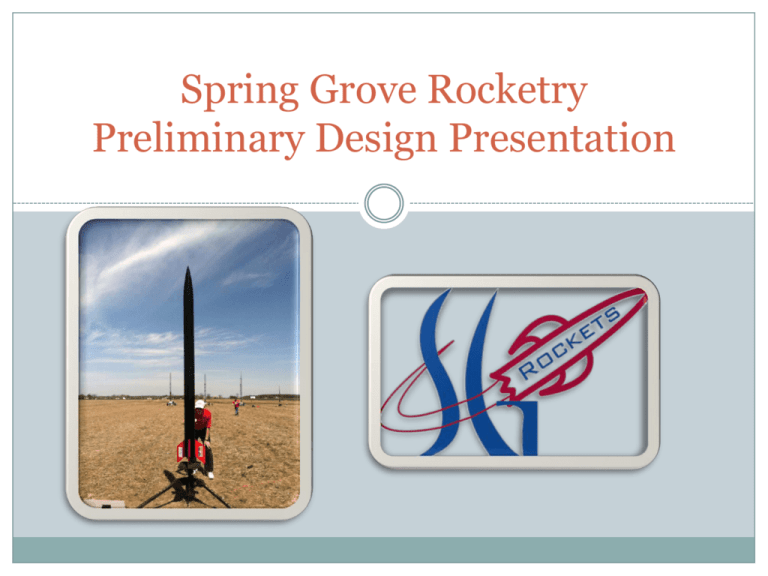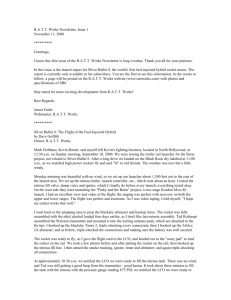Vehicle Properties - Spring grove rockets
advertisement

Spring Grove Rocketry Preliminary Design Presentation Vehicle Properties Total Length: 85.25” Diameter: 4” Gross Lift Off Weight: 23.62lb Airframe Material: Fiberglass Wrapped Phenolic Airframe Tubing Fin Material: 3/16” G10 Fiberglass Drag Coefficient: 1.1 Motor Properties Motor Manufacturer: Cesaroni Technology Inc. Motor Designation: K510 Classic Max/Average Thrust: 155.07 lb/ 155.55 lb Total Impulse: 558.85 lb * ft/ sec Mass Before/After Burn: 2,590g/ 1,393g Liftoff Thrust: 32.60 lb at .1sec 4.8 sec burn time Stability Analysis Center of Pressure: 59.522” Center of Gravity: 48.144” Static Stability Margin: 2.84 Thrust-to-Weight Ratio: 4.892 Rail Size (in.)/ Length (in.): 1.5”/96” Rail Exit Velocity: 52.14 ft/sec Ascent Analysis Maximum Velocity: 594.28 ft/sec Maximum Mach Number: 0.53 Maximum Acceleration: 175.23 ft/s^2 Target Apogee: 5,654 ft Target is higher than desired 5,200 ft because we are accounting for an increase in mass between Rocksim design and actual design Stable Velocity: 43.99 ft/sec Distance to Stable Velocity: 5.77 ft Recovery System (Drogue) Manufacturer/Model: Fruity Chutes/ Iris Ultra 36” Altitude at Deployment: 5,654’ Velocity at Deployment: 8.43 ft/sec Terminal Velocity: 43.06 ft/sec Recovery Harness Material: Tubular Nylon Harness Size/Thickness: 1” Width/ 1/8” Thickness Recovery Harness Length: 15’ Recovery System (Drogue) Kinetic Energy of Each Section Section 1: 57.59 ft-lbs Section 2: 334.1 ft-lbs Section 3: 288.0 ft-lbs Recovery System (Main) Manufacturer/ Model: Fruity Chutes/ Iris Ultra 72” Altitude at Deployment: 600ft Velocity at Deployment: 43.06 ft/sec Terminal Velocity: 17.10 ft/sec Recovery Harness Material: Tubular Nylon Harness Size/ Thickness: 1” Wide/ 1/8” Thick Recovery Harness Length: 20ft Recovery System (Main) Kinetic Energy of Each Section Section 1: 9.07 ft-lbs Section 2: 52.66 ft-lbs Section 3: 45.44 ft-lbs Section 4: 7.54 ft-lbs Recovery Electronics Altimeter/Timer Make and Model: Perfectflite Stratologger Redundancy Plan: Two altimeters with two ejection charges for each event (drogue deployment and main deployment). One will have a slight delay from the other to ensure ejection. Pad Stay Time: Each altimeter has a battery life up to four hours on the launch pad. Recovery Electronics Black Powder Mass Drogue Chute: 2.0g Black Powder Mass Main Chute: 2.0g Test Flights We have selected manufacturers and the location for the sub-scale launch. Materials have not yet been ordered. Potential Risks of the SL Rocket Program Minor to severe bodily harm due to power tools and other equipment. Complications with the design and/or building materials. Complications in planning and/or schedule. Physical harm and/or property damage in launching and landing of the rocket. Plan to Reduce Risks Be careful when handling equipment. Creation of alternate plans to deal with complications with the rocket Creation of alternate plans to deal with scheduling and planning Check all rocket system and parts prior to launch and be aware during the launch process. Failures for Rocket Design Breaking of bulkheads or centering rings, and using a motor that is unable to carry the rocket and payload to the proposed height. Rocket may be instable or the structural integrity of the body tube is not great enough to handle the high forces and pressure that it will undergo. Problems With Payload Payload being too large for the selected tube Not being able to properly attach to the shock cord Insufficient space due to other interior parts Failures in Launch Operations Motor delay, the ejection charge not being set off, Having an ejection charge that is not powerful enough to break apart the rocket to provide a safe decent. Environmental Concern Rocket could get lost after launch and become unrecoverable Animals and plants could be harmed from the potentially hazardous chemical components of the rocket and payload. The burning of the black powder and motor can produce potentially irritating, corrosive, or toxic gases. Major Challenges and Solutions The major challenges that are most likely to accrue are either safety hazards, not raising enough money for the competition of our project, or going over the budget we have set out for our project. The best way to avoid safety hazards is to have team members and supervisors read the all operation manuals for the tools and products that will be handled during the completion of our project before proceeding with any of such devices or products, while following the enclosed safety plan. We will also address if a team member is comfortable with using a tool at any time or not. Major Challenges and Solutions (cont.) To raise enough funds for our project we will be holding public outreach programs for funding and support. We will be contacting local businesses for grants. To stay on budget, we will keep track of all funds being used and track whether the prices of materials are within the projected cost by researching for the best pricing of the materials. If going over budget is inevitable, due to rising prices of materials, we will raise more funds from companies using our progress on the project to incite sponsorship from more companies and businesses. Plan for Sustainable Support of Rocket Project In order to make it to Huntsville, we want to work with people, local businesses, and corporate sponsors in and around the Spring Grove area. We plan on spreading awareness of our rocketry programs at Spring Grove to every adult and student in the area. To accomplish this we would like to create hands-on learning experiences for kids in our community to explore and learn more about the rocketry field. This includes giving a presentation to inform Spring Grove Middle and Spring Grove Intermediate students about the design and engineering of rockets. We will teach as many students as possible about rocketry and aerospace as It is one of our goals in giving presentations to interest people in joining our science clubs. We will also be holding public out-reach and funding programs at school and local events to help with awareness of our project to get the attention of adults of our community. Plan for Sustainable Support of Rocket Program (cont.) We hope to have small groups work together and build small scale rockets, Each group will have an SLI member directing the group to help teach the students to build the small rocket. If feasible, we may launch the said rockets (if they are deemed safe to fly). We want to provide fun hands on experience for our students so more students will be interested in joining TARC and potentially even SLI in the future. In order to spread public awareness, we are planning to contact television stations, such as FOX and our local news channels , to see if they are interested in making a short segment on the SLI program of Spring Grove High School. We will also contact local radio to see if they are interested in speaking on behalf of our program here at Spring Grove. Recovery Subsystem Our rocket will be using two separate chutes on its decent to slow it down enough for a safe impact. The rocket will come down in four separate sections all connected by shock chord. The chutes we are using are a Iris Ultra 36 inch drogue chute and a Iris Ultra 72 inch main parachute. The 36 inch drogue chute will come out at apogee. A charge in the electronics bay will push out the payload and the chute from the front half of the rocket. Recovery Subsystem The second chute is our 72 inch main parachute. This chute will be deployed at 600 feet by another charge in the electronics bay. This charge will separate the electronics bay and the 72 inch parachute from the back half of the rocket. Each ejection will have a redundant altimeter set on a delay to ensure that both halves fully eject. The Iris Ultra chute was chosen for its high coefficient of drag. The Fruity Chutes website lists the coefficient of drag at 2.2. This type of parachute allows for more drag with a smaller size diameter. Payload The payload is designed to test the variance and effect of hole size on Perfectflite Stratologger altimeters. The payload fits inside the body tube, directly below the nose cone. It is 13 inches long, with an exterior 3.78 inch diameter phenolic coupler tube. The payload is made of three compartments, each separated by a sealed bulkhead. Within each section are three Stratologgers and a single 9 volt battery that provides power to the 3 Stratologgers in its own section. A U-bolt will be attached to both end bulkheads, which will be attached to the drogue parachute to be deployed at apogee, and to the nosecone. Payload The payloads compartments will be completely sealed until ejection, at which point it will take data. The payload has four 3D printed ½” thick bulkheads with holes for the all thread preprinted for a clean fit. The bulkheads will have lips, so that the coupler tube will slide into the lips cleanly. The all thread will run through the entire payload, making the disassembly of the payload easier. The all thread will screw on both ends, sealing all compartments and keeping all parts in place. This, along with the prefabrication of the lips, should create a sealed container for the altimeters to function correctly. The altimeters are fastened onto “walls”, which are 3D printed as one piece onto the bulkheads. Payload Safety Preliminary checklist Test altimeters in Payload Payload sections need to be airtight Check wiring in ebay section Check altimeters in ebay Fold drogue parachute properly Fold main parachute properly Observe and monitor the building of motor by our mentor Put payload in top body tube then pack drogue parachute Pack main chute in bottom section of body tube Connect both body tubes with ebay section Put shear pins in ebay holding rocket together Test key switches Take rocket to pad with igniter Place rocket on pad and arm altimeter, then remove key switches Place igniter in motor Safety Officer: Robert DeHale Funding Plan Plans for fundraising include: Nuts About Granola Bonus Books Cotton Candy Avon Products Rocket Space Christmas Wreaths and Poinsettias Funding Plan (cont.) Efforts will be made to: Contact local businesses for potential sponsorships or donations. Apply to any grants that the Spring Grove Student Launch is eligible for. Funding Plan (cont.) Currently… We have netted approximately $500 on cotton candy sales. We have netted approximately $200 on granola sales. We have received a donation of $5,000 from the Spring Grove Educational Fund and $500 from Advanced Application Design Inc, a business located in North Carolina. Bonus Book and Christmas sales are underway. Budget Plan Timeline and Team Schedule September 11. Request for Proposal (RFP) is successfully received from NASA October 6. Electronic copy of completed proposal is delivered to NASA officials 17. Confirmation of acceptance of completed proposal 18 – 31. The team will have meetings twice a week to work on PDR documents and presentation. 31. Team has a working website and meetings are occurring frequently Timeline and Team Schedule (cont.) November 3. Safety Briefing for our team 4. Review completed PDR prior to posting on website 5. Preliminary Design Report (PDR) report, presentation slides, and flysheet posted on the team. Website by 8:00 a.m. Central Time 6. Practice PDR presentation 7-21. PDR video teleconferences January 3. Subscale Launch for our team in Price, Maryland 4-16. Team meetings to work on CDR documents and presentation. 16. Critical Design Report (CDR) report, presentation slides, and flysheet posted on the team. Website by 8:00 a.m. Central Time 20. Practice CDR Presentation. 21-31. CDR video teleconferences Timeline and Team Schedule (cont.) February 1-4. CDR video teleconferences 5-27. Built full scale rocket including payload. Test ejection charges at ground level.38 28. Full Scale Launch in Price MD. March 7. Full Scale Launch in Price MD 8-15. Work on FRR documents and presentation. 16 Flight Readiness Review (FRR) report, presentation slides, and flysheet posted on the team. Website by 8:00 a.m. Central Time 17 Practice FRR presentation. 18-27 FRR video teleconferences Timeline and Team Schedule (cont.) April 3. Pack rocket, tools and all parts for Huntsville trip 6. Teams Travel to Huntsville, AL 7. Launch Readiness Review (LRR) 8. LRR and safety briefing 9. Rocket Fair and Tours of MSFC 10. Mini/Maxi MAV Launch day, Banquet 11. Middle/High School Launch Day 12. Backup launch day 29. Post-Launch Assessment Review (PLAR) posted on the Team. Website by 8:00 a.m. Central Time Educational Engagement We will be holding presentations at both our middle school and intermediate school. We also will have a more basic presentation for the elementary schools, inviting them on a rocket awareness camp. We will be setting up a table with information at various events such as home football games, back-to-school night, and other home sporting events We also will be holding an event where younger students from the intermediate school and middle school will have an opportunity to build small rockets in groups with the help and supervision of SLI and TARC members They will complete surveys to obtain feedback Educational Engagement We will then form a TARC team at the middle school for all those who are interested We will be holding a field trip for the elementary students to teach them basic things about rocketry and really just get them interested in the subject. They will spend a day at the high school learning rocket poems and dances, building and eating their very own rocket snack, and having a chance to tiedye a rocket t-shirt.







